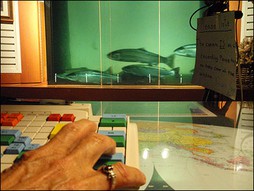forum
library
tutorial
contact

Salmon, Steelhead Numbers Surge
in Some Northwest Rivers
by Tom BanseOregon Public Broadcasting, August 16, 2010
|
the film forum library tutorial contact |

|
Salmon, Steelhead Numbers Surge
by Tom Banse |
 Banner runs of salmon and steelhead are migrating up some Northwest rivers this summer. Not since dams were constructed on the Columbia and Snake Rivers have this many sockeye salmon returned.
Banner runs of salmon and steelhead are migrating up some Northwest rivers this summer. Not since dams were constructed on the Columbia and Snake Rivers have this many sockeye salmon returned.
Meanwhile, it looks like the 2010 summer steelhead run on the Columbia may be the second highest on record. The modern record for steelhead was set in 2001. Tom Banse reports on some possible explanations for these unexpectedly high salmon numbers.
Bonneville Dam was finished in 1937. Ever since, fish counters have sat in front of big underwater picture windows there. Fish ladders at the dam funnel spawners past the windows.
Jane Jackson: "Whoa! Look at that big, big Chinook... Steelhead..."
Park ranger Jane Jackson calls out the fish as a human counter keeps track with a clicker.
Jane Jackson: "Wow! A wild Chinook... and another one. Hatchery, hatchery...."
Tom Banse: "We've got a big group here. One, two, three, four, five, six, seven coming by the window..."
Rarely have salmon and steelhead filled the windows as they have this year.
Jane Jackson: "Oh, that one has got a scrape."
The run of endangered Snake River sockeye has set a modern record. The returns are more than double the pre-season forecast.
Right on its tail comes a blockbuster steelhead run. Columbia River wild steelhead are listed as threatened. Steelhead resemble salmon, but are technically an ocean-going trout.
Downstream of the dam, dozens of fisherman cast lines from the riverbank for marked hatchery-origin fish.
Jeff Seale: "Ha! Holy smokes, look at that."
Sport fisher Jeff Seale reels in the biggest steelhead he says he's ever caught. It's longer than his outstretched arm and weighs maybe 14 pounds.
Jeff Seale: "Last year was good and I'm hoping this year is just as good."
Nearby, fisherman Mike Lazelle of Carson, Washington throws out some theories with his line.
Mike Lazelle: "It's probably good ocean conditions have led to a good run this year. I'm sure it's probably nothing we did."
Biologists say it's hard to prove cause and effect because there are so many variables in play. A spokesman for the U.S. Army Corps of Engineers would like to believe that all the money spent on dam improvements "is finally paying some dividends."
Tribal fisheries biologist Stuart Ellis sees benefits from a court order to spill more water over the tops of dams in the summer. That's instead of running the water - and young fish -- through the power turbines.
Stuart Ellis: "One of the things that likely has occurred with these particular fish is that we've had really good outmigrating conditions for the juveniles.
A colleague of Ellis' in Portland, Jeff Fryer, mentions that fishing has been greatly reduced in places to protect threatened runs.
Jeff Fryer: "Back when I started in the late eighties when you had a big run we'd harvest 50 percent or so. It was a much bigger harvest allowed."
Then there's the question of whether increased hatchery production can explain higher salmon returns. State and federal fish & wildlife agencies discount this possibility. They say hatchery production overall has held pretty steady.
A caveat now.
Stuart Ellis points out that for every Northwest salmon run that's exceeded the pre-season forecast, he can find one that's struggling.
For example, this year's run of Lake Washington Chinook is falling way short.
Stuart Ellis: "You have to have enormous humility to work in this business, because these fish are masters at faking you out. As soon as you think that you've got some real understanding of what these fish are doing and what kind of factors are influencing their survival, something will change."
Ellis is sure salmon will need intensive management into the foreseeable future. He says the region's growing population, a warming climate and increasing demands for water are just some of the reasons why.
learn more on topics covered in the film
see the video
read the script
learn the songs
discussion forum
